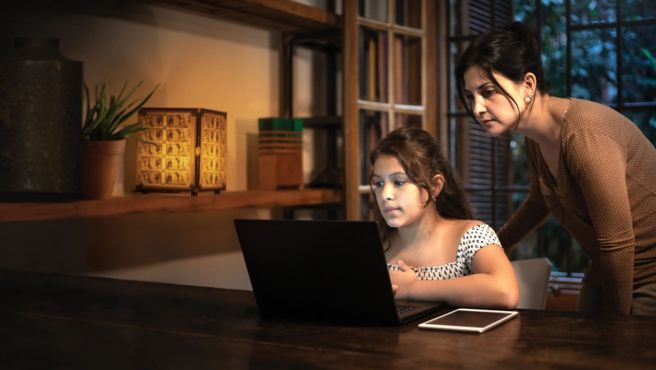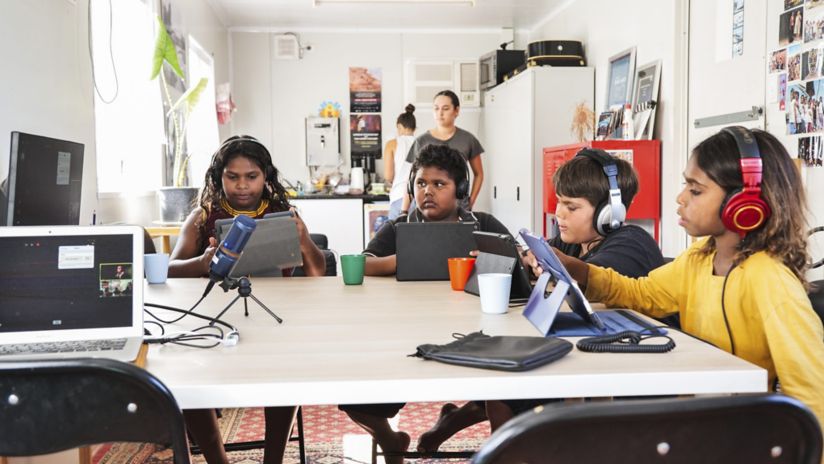Keeping kids safe online
The internet is brimming with resources to help keep your kids safe online. We've collected a few that are useful, educational - and fun!

Our top online safety tips
- Show positive interest in your kids’ online life by getting involved.
- Have tricky, but open conversations about pornography, sexting, online bullying or other content that may be harmful (and how to keep them safe from it).
- Teach kids to recognise online scams and set secure passwords.
- Set up a family tech agreement.
- Establish limits with parental controls.
Visit the eSafety Commissioner for more tips on keeping your kids safe online.
For parents, letting your kids loose on the web (or letting the web loose on your kids) can be a nerve-wracking experience. Handling that experience can be complex, but also rewarding. We've outlined a few key issues to help your child have the safest online experience possible.
Get involved in your kids’ online life
Parents who’ve spent time playing the games and using the social media apps their kids use report they have more clarity about how their kids interact online. This fosters deeper understanding and empathy when talking with their kids about online safety. Going online together also shows you're interested in their online life - and they'll be more inclined to trust you.
Engage your kids in chats about the internet, the latest apps and devices, what their friends say and do online and who they’re chatting with. This all keeps you on the front foot if anything goes awry.
By being 'digital literate', which means knowing how to use digital tools and technologies, parents and carers can help foster a safe and healthy digital environment at home.
Hot tip: Ask your child to show you how to use an app they love and watch them enjoy the role reversal.
Why digital literacy matters for parents and carers
Talk about difficult things with your kids
While lots of online experiences can be wonderful and fun, there’s a bunch of dubious info out there too. From talking to strangers, to bullying, to encountering unwanted content or behaviour, to oversharing personal information, a child who’s still learning the ropes of online safety can be exposed to many risks. Tools like parental controls can help limit that exposure, but the only way to really understand what’s going on and how it might be affecting your kid is to talk to them, even if it’s tricky.
Some great conversation starters are:
- Have you seen something online that made you feel worried?
- Do you ask permission before posting photos of others online?
- What would you do if someone sends you something inappropriate?
Experts recommend finding a place to talk where you will not be interrupted. Remain non-judgemental and supportive to encourage them to open up, particularly when it comes to tricky issues like sex and pornography.
Resources to help you have hard conversations about online use
- Telstra have partnered with The Alannah & Madeline Foundation to deliver the DigiTalk Online Safety Hub for parents and carers, providing tips and tricks that are easily accessible, digestible and actionable.
- For tips on how to start the chat, with specific advice for different age groups, visit Hard-to-have conversations – eSafety
- Tricky conversations, whether about the online or real world, involve lots of feelings. Kids, however, often can’t express them properly with words and use other forms of communication. To learn how to encourage your kid to express feelings and how you can better pick up on them, visit Helping kids identify and express feelings – Kids Helpline.
Get savvy about passwords, personal info and online scams
These days, the line between public and private life is blurred. That's why it's important to talk to your children about personal information, what it is and why it's so valuable. Explain how entering information on devices and websites can potentially leave them exposed. Help your kids set up strong passwords, encourage them to be cautious when sharing information or clicking links in messages and help them strengthen their privacy settings on social media.
While they're still young, teach your kids not to share passwords with others or across different sites and accounts and get them into the habit of using passphrases. A passphrase is a strong type of password that has four or more random words like 'cat mushroom plate biscuit', which are hard to guess, but easy to remember. Turn on multi-factor authentication where possible, which makes it much harder for anyone but yourself or your kids to access their account.
Resources to help your kids understand cyber security
Visit Interland – Google, a great (and fun) place for kids to learn how to be ‘internet awesome’.
It has four games focused on cyber security:
- Kind Kingdom: learn how to respect others online
- Reality River: learn about online scams and phishing
- Mindful Mountain: learn about sharing personal info
- Tower of Treasure: learn about passwords to help secure your personal info, or ‘secrets’, from hackers.
Establish ground rules and a family tech agreement
It’s important to set guidelines around the use of tech and the internet for kids. The best approach is for parents and children to do it together so your kids feel included and gain a sense of responsibility.
Some ideas include using computers or other devices in a central area like a lounge room or keeping doors to bedrooms open if kids are using devices there. You can also create a family timetable to manage downtime away from tech.
Learn how to balance screen time for families
Set limits with parental controls and account controls
Parental controls are very handy and offer multiple ways to manage your child's access to the internet. Start by checking your device's operating system, search engine and specific gaming platforms to help control what your kids can see and do online. For example, most search engines will let you switch on SafeSearch, which will filter out inappropriate or unwanted content like pornography or violence.
You can also set time, functionality or age limits on the use of devices, software (like games) or streaming services, which can be useful to enforce some of the ground rules you may have set up in your family tech agreement. Be sure to familiarise yourself with these settings and controls.
Resources to help you understand parental controls
- Parental controls – eSafety: A comprehensive guide to parental controls on different platforms and apps.
- Parental control and content filter resources – Telstra: Links to parental control guides for various services, devices and apps (like streaming or gaming services).
- How to filter explicit search results with SafeSearch – Google: This will tell you how to turn SafeSearch on or off on computer, Android, iPhone and iPad.
Be a role model
Set a positive example. Tell your kids what you value and how you expect others to behave. Show them you're careful with your devices by locking the screen, turning your phone off at mealtimes and never using your phone while you drive. Share your own online experiences or when you’ve found a cool new app your kids might like. Including them could encourage them to include you too.
Encourage your kids to be respectful and kind online by teaching them digital etiquette.
You're the role model, so leading by example is the perfect way to get your kids to follow your lead.
Are you ready for the DigiTalk?
Telstra has partnered with the Alannah & Madeline Foundation to bring you an online safety hub. It covers topics like healthy tech use and screen time, gaming, social media, digital ethics and more!
Explore more on this topic

Our Digital Family Hub
Visit us for more resources and tips on navigating the digital world with confidence.
Explore our tips


